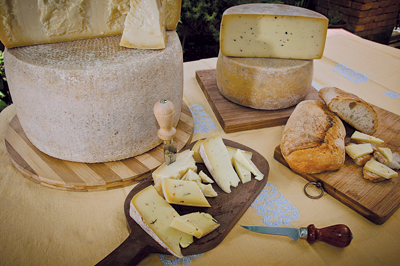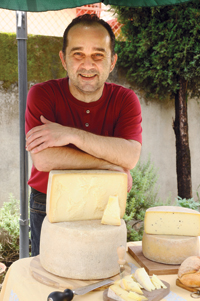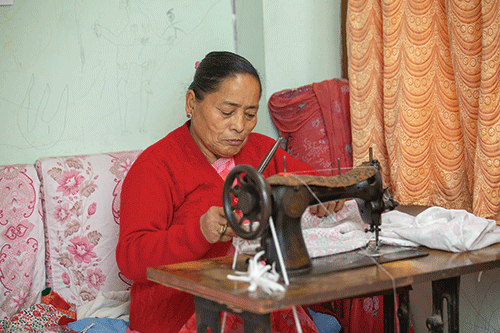Nepali cheese production started the same year as the first successful ascent of Everest. It’s only fitting that now in its 60th anniversary year, with the help of local and expat cheese makers; Nepali cheese is coming into its own.
1953: The Milkman Cometh
With the Swiss Aid Agency’s initiation, Werner Schulthess, a Swiss national was successful in setting up a dairy in Nepal that made pasteurized milk available to all in the valley. He dedicated a lot of his time taking care of the production, distribution and marketing of the milk. Schulthess saw better prospects higher in the mountains but distance was the biggest hindrance for him so he thought of transporting it in the form of cheese.
After working hard for several months with his Sherpa friends, he finally introduced cheese to the public for free. To his surprise the locals loved the taste and thus began his relentless journey toward starting the cheese plant and factories which supply cheese to Kathmandu even today.
 2003: Made in Nepal
2003: Made in Nepal
“I will always make goat cheese no matter what”, says Ashok Kumar Thakuri, a man synonymous with goat cheese production in Chitlang, a small village situated in the south of Kathmandu. After he received training from France he started manufacturing goat cheese for the first time in Nepal. “The production in Chitlang is the only one as far as goat cheese is concerned” he says proudly. Ashok uses French and Belgium technology as well and makes almost 5-7 kilos of cheese a day. He has been an inspiration to many individuals who have been interested in cheese making, and has helped and trained many individuals from other parts of Nepal.
Cheese Varieties: He makes two types of cheese- soft and hard - and other six to seven different organic flavored cheeses. The product is directly sent to hotels and restaurants in Kathmandu.
Rates: The soft variety costs 1500 rupees/kg and hard cheese is sold for 2500 rupees/kg.
Why goat? He believes goat cheese has a distinct flavor and is really healthy. It’s easily digestible than cow or yak milk. He says every Nepali household should have one slice of cheese every week if not every day.
2007
T he French Way
he French Way
Cheese production in Nepal would be incomplete without Francoise Driard. Everybody knows him as the ultimate cheese maker and Francois’s hard work, dedication and passion is commendable. His was the first western style cow cheese production facility in Nepal. Cheese is popular mostly among the expats and foreign nationals, “but because of the rapid cultural changes, cheese consumption is steadily increasing in Nepal,” he says, adding that “cheese is more expensive than meat and people prefer meat over cheese and that is where the challenge lies.”
Cheese varieties and rates: His famous Tomme cheese is priced at 1600 rupees/kg and Cream Cheese at 1000 rupees/kg
Best Cheese experience: Tomme cheese on a piece of fresh baguette with a glass of red wine or melted on bread or with potatoes.
Yak Cheese? “Yak cheese can be very good, just that it would benefit immensely if aged for 6 or 9 months more, and then the taste would come out fruity and everything”.
2007 Mambo Italiano
Sandro Serafini came to Nepal in 1989 on a holiday and as has happened to many expats, fell in love with the place. Although he does not own cows like Francois, Sandro produces high quality cheese and has a list of loyal customers who simply love its taste. He produces 260-270 kilos of cheese in a month and supplies it to popular restaurants like Roadhouse cafe, Fire & Ice, OR2K and Organic Café to name a few. Sandro loves food like any other Italian and he says he could create new cheese everyday if he could and he simply loves trying out new flavors. “Cheese goes with anything, it’s what you feel is more important.”
Rates: The least expensive is the Ricotta sold at NRS 800/kg and then it goes up till NRS 1600/kg
We have our Frenchman Francois, Italian Sandro, Sandra Subedi from Pokhara, Ashok from Chitlang who have helped Nepal come a long way as far as quality cheese production is concerned and with passionate individuals like them who believe in their product we have only to broaden our minds and appreciate the hard work that goes into making that small slice of cheese on your plate. Why buy expensive imported cheese when we have easily available variety cheese that is made from local cows, yaks and goats? We definitely have what it takes to call it our own.
Milk & Cheese Varieties
1. Butter
2. Ghee
3. Ricotta- It is an Italian whey cheese made from sheep, goat, cow or Italian buffalo milk whey left over from the production of cheese. “It’s not really cheese” says Sandro, “it has lots of protein and no fat”.
4. Mozzarella- Mozzarella is a fresh cheese, originally from southern Italy, traditionally made from Italian buffalo or cow’s milk. “These soft and semi-soft cheeses are made and sold within 24 hours” Sandro adds. Mozzarella is used in many types of pizza and several pasta dishes.
5. Scamorza-It’s very similar to mozzarella. Although it is available across the country in the smoked and unsmoked forms it is a product of Puglia and made throughout Bari Province.
6. Caciotta- It’s mostly made in the central regions of Italy. Caciotta in different flavors like rosemary, fenugreek or methi, cumin or jeera etc-Chef Paul Atchison who is known for his creative dishes is one of his regular customers.
7. Parmesan or Parmigiano-Reggiano is a hard, granular cheese produced in the areas near Parma, Reggio Emilia, Modena, and Bolognaand Mantova (in Lombardia), Italy. Parmigiano-Reggiano is most commonly used in pasta, soups, risottos etc.
8. Blue cheese- Sandro occasionally makes this cheese which has clear blue veins and a very distinct smell to it. Gorgonzola is one of the oldest known blue cheeses, having been created around 879 AD.











